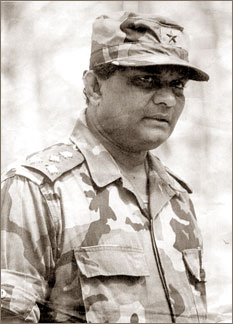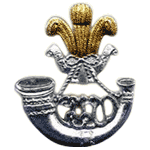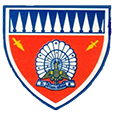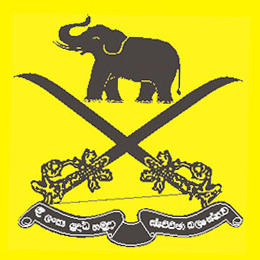
Major General Vanigamuni Indrajith Vijeyakumar Mendis Wimalaratne, RWP, RSP, VSV, USP was a senior Sri Lanka Army officer. One of the most distinguished field commanders in Sri Lanka, Wimalaratne raised the Gajaba Regiment, he commanded the 1st Brigade during the Vadamarachchi Operation, he commanded the Amphibious Task Force Commander during Operation Balavegaya and was the Commander Security Forces – Jaffna at the time of his death in a land mine explosion at Point Arali in the Kayts Island while making preparations to re-capture Jaffna.

The Sri Lanka Army is the oldest and largest of the Sri Lanka Armed Forces. The army was officially established as the Ceylon Army in 1949, though the army traces its roots back in 1881 when Ceylon Light Infantry Volunteers was created; the army was renamed as the 'Sri Lanka Army' when Sri Lanka became a republic in 1972. In 2024, the Army had approximately 150,000 personnel.
The Special Forces Regiment (SF) (Sinhala: විශේෂ බලකාය Visēsha Balakāya;) is a special forces unit of the Sri Lanka Army. Founded in 1986 as a combat tracker team, it was established as a regiment in 1988, and later expanded into a brigade. The unit specialises in a number of roles including counter-terrorism, direct action and covert reconnaissance. Much like the British Army Special Air Service, much of the information about the SF is highly classified due to the secrecy and sensitivity of its operations.

The Sri Lanka Light Infantry (SLLI) is the oldest regiment in the Sri Lanka Army and the oldest infantry regiment in the army. It is made up of sixteen regular battalions and nine volunteer battalions, and is headquartered at the Panagoda Cantonment, Panagoda.

The Sri Lanka Sinha Regiment (SLSR) is an infantry regiment of the Sri Lanka Army; it is the second oldest infantry regiment in the army.

The Gajaba Regiment (GR) is an elite infantry regiment of the Sri Lankan Army. Formed on 14 October 1983 at the Saliyapura Camp in Anuradhapura, it is named after the famous Sinhalese King Gajabahu the First. It consists of 14 regular battalions and 6 volunteer battalions.

The Gemunu Watch (GW) ("King Dutugemunu's Own") is a infantry regiment of the Sri Lanka Army, formed with troops from the Ceylon Light Infantry and the Ceylon Sinha Regiment in 1962. It has been deployed in many major operations against the LTTE. It is made up of 14 regular units and 9 volunteer units. Headquartered at Kuruwita Army Camp, Ratnapura. It is named after one of the most famous Lankan Kings, King Dutugemunu.

The Sri Lanka Army Volunteer Force (SLAVF) is the active-duty volunteer reserve force of the Sri Lanka Army. The SLAVF is separate from the Regular Force which consists of personal who are professional soldiers and its Regular Reserve, which comprises personal who have a mobilization obligation following their service in the regular army. The SLAVF consists of the volunteer force and the volunteer reserve; administration and recruitment of reserve personal is carried out by the Volunteer Force Headquarters in Shalawa, Kosgama which is headed by the Commandant of the Volunteer Force. It has a current strength of about 55,000 personnel. The SLAVF was known as the Ceylon Volunteer Force from 1949 to 1972 and the Sri Lanka Volunteer Force from 1972 to 1985.
The Rajarata Rifles was a former rifle regiment of the Sri Lanka Army. It was one of only three geographically based regiments in the Sri Lanka army. The cap badge of the Raja Rata Rifles show the figure of a Bherunda Pakshiya.
The Battle of Mullaitivu, also known as the First Battle of Mullaitivu and codenamed Operation Unceasing Waves-1, was a battle between the militant Liberation Tigers of Tamil Eelam and the Sri Lankan military during the Sri Lankan Civil War for control of the military base in Mullaitivu in north-eastern Sri Lanka.
The Battle of Pooneryn took place between the militant Liberation Tigers of Tamil Eelam and the Sri Lankan military during the Sri Lankan Civil War for control of the military base in Pooneryn in northern Sri Lanka from 11 November to 14 November 1993.
Colonel Aslam Fazly Laphir, PWV, RWP, RSP, SF was a Sri Lankan Army officer and posthumous recipient of the Parama Weera Vibhushanaya (PWV). He was awarded the PWV for his actions leading the 1st Special Forces Regiment during the Battle of Mullaitivu in which he was killed. Colonel Laphir played a major role in the formation and development of the Special Forces Regiment from the original Combat Tracker Team.
Boyagane Army Camp is a military base located close to the town of Kurunegala in the North Western Province of Sri Lanka. It serves as the regimental headquarters of the Vijayabahu Infantry Regiment of Sri Lanka Army.
General Shavendra Silva, is a Sri Lanka Army four star general who is the current Chief of Defence Staff, the head of the Sri Lanka Armed Forces serving from 1 January 2020. He also served as the Commander of the Sri Lanka Army from 19 August 2019 to 31 May 2022. His other important appointments include, Chief of Staff of the army, Adjutant General and Director of Operations of the Army. During the Sri Lankan civil war he gained fame as the General Officer Commanding of the elite 58 Division. He had also served as the Deputy Permanent Representative to the United Nations Headquarters.
G. D. H. Kamal Gunaratne, WWV, RWP, RSP, USP is a retired Sri Lankan army general. He is the Secretary to the Ministry of Defence and the State Ministry of National Security and Disaster Management. A retired career officer of the Sri Lanka Army, Gunaratne had served as the former Commander Security Forces Headquarters - Wanni, general officer commanding (GOC), 53 Division and was a former Deputy Ambassador to Brazil. He was the GOC of the 53 Division which killed the LTTE leader Velupillai Prabhakaran at Nandikadal, Mullaitivu.

The 66 Division is a division of the Sri Lanka Army. Established on 1 January 2009, the division is based in Pooneryn in the Northern Province, Sri Lanka. The division was a part of Security Forces Headquarters – Kilinochchi but now the division is part of Security Forces Headquarters – Mullaitivu and has three brigades and seven battalions.
Major General Jagath Dias, WWV, RWP, RSP, USP was a Sri Lankan general, who served as the Chief of Staff of the Sri Lanka Army. He was the General Officer Commanding, 57 Division and 56 Division. He was the Sri Lankan Deputy Ambassador to Germany, Switzerland and the Vatican.

General L. D. E. Cecil Waidyaratne, VSV, USP was a Sri Lanka Army general. He was 12th Commander of the Sri Lankan Army and a former Sri Lankan Ambassador to Thailand.

Major General Galwaduge Janaka Laksiri Waduge, RWP, RSP, VSV, USP, ndu is a retired Sri Lankan army general. He was the 10th Commander Security Forces Headquarters – Central and the former Colonel commandant of Military Intelligence Corps. He retired from active service in 2020 upon reaching the mandatory retirement age of 55 for Sri Lankan Armed Forces Personnel.
The regimental centre of a regiment is its administrative center in the context of a multi-battalion regiment. Common in British Commonwealth such as in the Indian Army and the Sri Lanka Army, regimental centres are similar to regimental depots of the British Army. Many regimental centres started off as a headquarters company or battalion, becoming the regimental headquarters tasked with administration of personal, logistics and training. It is headed by the Regimental Centre Commandant.









